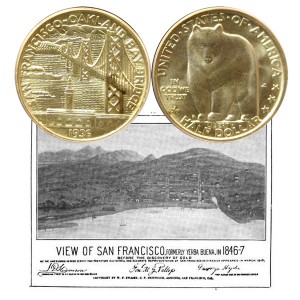Today, the San Francisco Oakland Bay Bridge Commemorative Silver Half Dollar Coin remembers when the name changed from Yerba Buena (Good Herb) to San Francisco 170 years ago.
On January 30, 1847, a signature on an ordinance forever changed the official name of the area.
From the Overland Monthly and Out West Magazine of March 1888:
=====
An Ordinance. Whereas, the local name of Yerba Buena, as applied to the settlement or town of San Francisco, is unknown beyond the district; and has been applied from the local name of the cove on which the town is built; therefore to prevent confusion and mistakes in public documents, and that the town may have the advantage of the name given on the public map; It is hereby ordained that the name of San Francisco shall hereafter be used in all official communications and public documents, or records appertaining to the town. Wash. A. Bartlett, Chief Magistrate. Published by order. – J. G. T. Dunleavy, Municipal Clerk.
=====
The book, San Francisco, As It Was, As It Is, and How to See it, by Helen Throop Purdy, published in 1912, provided insights into those early days of that frontier town on the bay:
=====
One of the first acts of Captain Montgomery was to appoint one of the lieutenants of the Portsmouth, Washington A. Bartlett, as Alcalde of Yerba Buena, and the little town of two score houses under American rule soon outstripped the village of Dolores, which formerly held supremacy.
Three weeks after the proclamation of Captain Montgomery, there was a large accession to the population. A ship, the Brooklyn, arrived from New York, with two hundred and thirty- eight immigrants, all but a dozen of them Mormons.
Their leader was Samuel Brannan, publisher of a Mormon paper in New York, who became in January, 1847, the publisher of the California Star, San Francisco’s first newspaper. A few months later The Californian, established by Walter Colton and Robert Semple in Monterey and the first newspaper of California, was removed to Yerba Buena.
The Mormons were mostly skilled mechanics and farmers and, being industrious, soon filled a useful place in the little community. They did not attempt to make converts and their descendants, if not they themselves, in general abandoned their peculiar faith.
By the dictum of the Alcalde, in 1847 the name San Francisco was substituted for Yerba Buena, the objections to the latter name being that it was difficult of spelling and pronunciation and did not properly represent the great bay which was well known on the Atlantic coast, and of which Yerba Buena hoped and expected to become the chief port.
Edwin Bryant was the second Alcalde. He was succeeded by George Hyde. About this time the boundaries of the town were extended south and west.
A census taken in 1847 reports the population of San Francisco, exclusive of officers and soldiers, as numbering four hundred and fifty-nine. This excludes also the village of Dolores, which was not then a part of San Francisco.
Of this population not more than half were natives of the United States. There were about forty each of Spanish-Californians, Indians and Kanakas.
In the seventeen months which ended in August, 1847, one hundred and fifty-seven houses had been built; a quarter of them adobe, the rest board shanties.
Many lots having been purchased and some buildings put up, stagnation ensued for a time, and it was agreed that something must be done to stimulate immigration.
Therefore, a special number of the California Star, for circulation in the East, was published in March, 1848. A six-column article by Doctor V. V. J. Fourgeaud set forth the attractions of San Francisco in somewhat exaggerated terms but giving considerable correct information.
A courier with two thousand copies was dispatched overland for Independence, Mo., which place it was expected he would reach in sixty days. From there the papers were to be distributed throughout the East.
Another edition, containing more information and offering more attractions for immigrants, was to be sent in the following June, but it was unnecessary.
Before that time the rumor of gold (which had been mentioned incidentally in the issue of March) had become a confirmed fact, the news of which it needed no special courier to disseminate.
…
=====
Of course, the history did not end there.
The story continued with the telling of the gold rush, the high inflation, the successes and failures, and the advancement through the years.
From just a few people in those early days, the town grew.
Today, the population of San Francisco proper is less than one million, however the population of the nine-county bay area is over seven million.
In the 1930s, the area, with help from the federal government, built the San Francisco Oakland Bay Bridge to improve transportation in the growing area.
The bridge used Yerba Buena Island to connect San Francisco and Oakland.
The San Francisco Oakland Bay Bridge Commemorative Silver Half Dollar Coin shows with an image of Yerba Buena in 1847.
